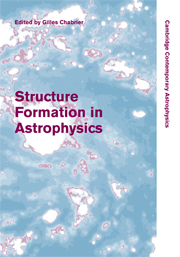Book contents
- Frontmatter
- Contents
- List of contributors
- Preface
- Part I Physical Processes and Numerical Methods Common to Structure Formations in Astrophysics
- Part II Structure and Star Formation in the Primordial Universe
- 6 New frontiers in cosmology and galaxy formation: challenges for the future
- 7 Galaxy formation physics
- 8 First stars: formation, evolution and feedback effects
- Part III Contemporary Star and Brown Dwarf Formation
- Part IV Protoplanetary Disks and Planet Formation
- Part V Summary
7 - Galaxy formation physics
Published online by Cambridge University Press: 11 August 2009
- Frontmatter
- Contents
- List of contributors
- Preface
- Part I Physical Processes and Numerical Methods Common to Structure Formations in Astrophysics
- Part II Structure and Star Formation in the Primordial Universe
- 6 New frontiers in cosmology and galaxy formation: challenges for the future
- 7 Galaxy formation physics
- 8 First stars: formation, evolution and feedback effects
- Part III Contemporary Star and Brown Dwarf Formation
- Part IV Protoplanetary Disks and Planet Formation
- Part V Summary
Summary
Introduction
A significant fraction of all efforts in astronomy is expended on studying the properties of galaxies and their spatial distributions over a very large fraction of all of cosmic time. Much of this is motivated by the mysteries of understanding dark matter and dark energy. The accuracy at which we can use galaxy clustering and other properties to determine the more fundamental parameters describing the universe is determined by the sophistication of our understanding of galaxies themselves.
As is by now well known, hierarchical cosmological models like ΛCDM predict that the first objects to collapse out of the expanding homogeneous universe are also the smallest. Since the early universe was also generally a simpler place (fewer heavy elements, etc.), this produces the anti-intuitive result that it is often easier to model the early universe. For the present-day universe, the significant complexities of the star formation process and the enormous range of relevant spatial and temporal scales forces us to employ phenomenological sub-grid models. In this contribution, we explore some aspects of our current understanding of galaxy formation with a distinctly numerical bias. We cannot hope to comprehensively review this topic, so instead we begin with a general overview of some of the important physical processes which are operating and then delve into a few current issues in more detail.
- Type
- Chapter
- Information
- Structure Formation in Astrophysics , pp. 159 - 179Publisher: Cambridge University PressPrint publication year: 2009
- 1
- Cited by



